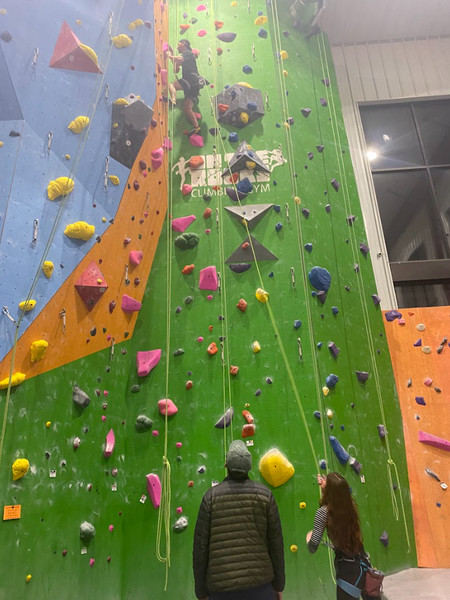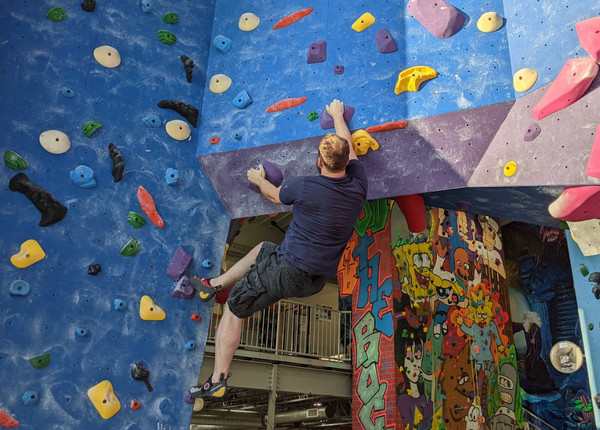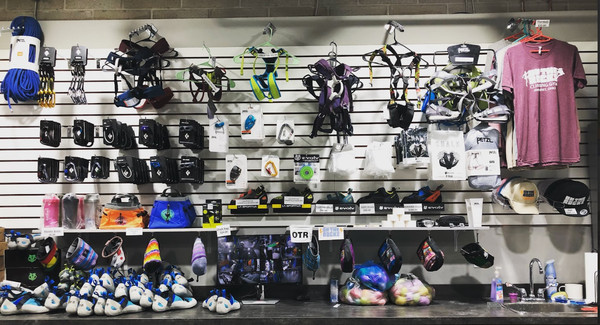Becoming a rock climber is an achievable goal, and rockscapes.net provides the perfect starting point. Rock climbing offers not only a fantastic full-body workout but also a chance to connect with nature, challenge yourself mentally, and become part of a vibrant community. Whether you’re drawn to the problem-solving aspect of bouldering or the endurance required for scaling taller walls, this guide will provide you with the knowledge to start your climbing journey, including resources for selecting the appropriate gear, finding climbing partners, and mastering essential techniques. Let rockscapes.net be your gateway to discovering the captivating world of rock climbing and unlocking your potential in this thrilling adventure sport!
1. Understanding Different Types of Rock Climbing
What are the primary rock climbing styles, and how do they differ?
Rock climbing involves various styles, each demanding unique techniques and equipment. As a beginner, focusing on top-rope climbing and bouldering provides a solid foundation. These styles offer different challenges and learning experiences, making them ideal for beginners.
- Top-Rope Climbing: This is ideal for beginners, as it involves climbing with a rope that runs through an anchor at the top of the climb. A partner, called a belayer, manages the rope to minimize falls. This method allows you to focus on technique and build confidence without the fear of long falls. Top-roping helps beginners learn essential movements and build confidence.
- Bouldering: Bouldering involves climbing shorter routes, or “problems,” without ropes, typically over a padded surface. This style emphasizes powerful, dynamic movements and technical problem-solving. It requires minimal equipment and can be done indoors or outdoors. Bouldering is an excellent way to improve strength, technique, and body awareness.
 Two rock climbers participating in top rope climbing
Two rock climbers participating in top rope climbing
2. Your First Climb: Indoor vs. Outdoor
Where should a beginner start their rock climbing journey: indoors or outdoors?
Beginning rock climbing is often best done indoors due to the controlled environment, making it easier to learn the basics. Indoor gyms offer a safer introduction to the sport, while outdoor climbing provides a more authentic experience but requires more advanced skills. For beginners, the accessibility and safety of indoor facilities make them ideal to start with.
- Indoor Climbing: Indoor climbing gyms provide a controlled environment with color-coded routes, padded floors, and readily available equipment rentals. These gyms offer a safe space to learn fundamental techniques, build strength, and gain confidence. Many gyms also offer introductory classes and experienced staff to guide beginners. The predictable nature of indoor climbing allows beginners to focus on technique without the added challenges of weather and natural hazards.
- Outdoor Climbing: Outdoor climbing offers a more authentic experience, but it requires a higher level of skill, knowledge, and preparation. Setting up ropes, understanding rock formations, and dealing with weather conditions can be challenging for beginners. However, with proper instruction and guidance, outdoor climbing can be a rewarding experience.
 A rock climber bouldering indoors
A rock climber bouldering indoors
3. Essential Rock Climbing Skills and Techniques
What basic skills are necessary for beginner rock climbers?
Rock climbing requires mastering specific skills, including knot tying, belaying, and understanding basic movements. Taking a beginner’s course is essential for learning these fundamentals safely and effectively. These skills form the bedrock of safe and efficient climbing.
- Knot Tying: Tying secure and reliable knots is crucial for rock climbing safety. The figure-eight knot is commonly used to attach the rope to the harness. Learning to tie this knot correctly is one of the first steps in climbing education. Consistent practice ensures that the knot is tied properly every time, reducing the risk of accidents.
- Belaying: Belaying involves managing the rope to protect the climber from falling. Belayers need to understand how to use belay devices, maintain a secure grip on the rope, and react quickly to a fall. Proper belaying technique is essential for the safety of both the climber and the belayer. Belaying also fosters trust and communication between climbing partners.
- Basic Movements: Efficient movement is key to conserving energy and climbing effectively. This includes understanding how to position your body, use your feet effectively, and maintain balance. Learning to use your legs more than your arms can significantly improve your climbing endurance. Mastering these basic movements allows climbers to tackle more challenging routes with greater efficiency.
3.1 Essential Gear for Beginner Rock Climbers
What essential gear is needed for beginner rock climbers, and what should you look for when acquiring it?
Essential rock climbing gear includes shoes, a harness, chalk, and appropriate clothing. Each piece of equipment plays a critical role in safety and performance. Ensuring your gear fits well and is in good condition is crucial for a safe and enjoyable climbing experience.
- Climbing Shoes: Climbing shoes are designed with sticky rubber soles to provide maximum grip on the rock. They should fit snugly but not be too tight, allowing for precise footwork. Beginner shoes often have a flatter sole for comfort and versatility.
- Harness: A harness is a system of straps that fits around the waist and legs, providing a secure attachment point for the rope. It should fit snugly and comfortably, with adjustable straps to accommodate different body sizes. Look for a harness with padded waistbelts and leg loops for added comfort.
- Chalk: Chalk helps to absorb sweat and improve grip. It is typically applied to the hands before and during climbing. Chalk comes in various forms, including loose chalk, chalk balls, and liquid chalk. Choose the type that works best for you.
- Clothing: Wear comfortable, breathable clothing that allows for a full range of motion. Avoid clothing that is too loose or restrictive. Many climbers prefer athletic wear made from moisture-wicking fabrics.
 Essential rock climbing gear
Essential rock climbing gear
4. Practicing and Improving Your Rock Climbing Skills
How can beginners effectively practice and improve their rock climbing skills?
Practicing regularly and consistently is crucial for improving your rock climbing skills. Taking a top rope test and climbing independently in an indoor gym after completing classes is an excellent way to reinforce what you’ve learned. Consistent practice builds muscle memory and refines technique.
- Top Rope Test: After completing a beginner’s course, taking a top rope test assesses your understanding of essential skills and safety procedures. Passing the test allows you to climb independently in the gym. This step is crucial for gaining confidence and putting your skills into practice.
- Independent Climbing: Climbing independently allows you to apply what you’ve learned in a self-directed manner. Experiment with different routes and techniques to find what works best for you. Pay attention to your body position, footwork, and breathing. Regular independent climbing builds strength, endurance, and technical proficiency.
- Joining a Climbing Community: Connecting with other climbers can provide valuable support, advice, and motivation. Climbing communities often organize events, workshops, and group climbs. Learning from experienced climbers and sharing your own experiences can accelerate your progress.
5. Advancing Your Rock Climbing Journey
How can rock climbers advance beyond the beginner level?
Advancing in rock climbing involves exploring different climbing styles, such as lead climbing, and setting up top rope anchors outdoors. Each step requires additional training and expertise. This progression allows you to continuously challenge yourself and explore new facets of the sport.
- Lead Climbing: Lead climbing is a more advanced technique where the climber clips the rope to protection points along the route as they ascend. This style requires a higher level of skill, confidence, and risk management. Taking a lead climbing course is essential before attempting this technique.
- Setting Up Top Rope Anchors: Learning to set up top rope anchors outdoors allows you to climb in a variety of natural settings. This skill requires a thorough understanding of anchor systems, rope management, and safety procedures. Taking a course on anchor building is crucial before attempting to set up your own anchors.
- Exploring Different Environments: Rock climbing offers opportunities to explore diverse and stunning natural environments. From indoor gyms to outdoor crags, each location provides unique challenges and rewards. Exploring different environments can enhance your climbing experience and broaden your appreciation for the sport.
5.1. Key Benefits of Rock Climbing
What are the key physical and mental benefits of rock climbing?
Rock climbing offers numerous physical and mental benefits, making it a rewarding activity. These benefits contribute to overall well-being and personal growth. Engaging in rock climbing can enhance both your physical and mental capabilities.
- Physical Fitness: Rock climbing is a full-body workout that improves strength, endurance, flexibility, and coordination. It engages muscles throughout the body, providing a comprehensive physical challenge. Regular climbing can lead to improved cardiovascular health and increased muscle tone.
- Mental Stimulation: Rock climbing requires problem-solving, focus, and mental resilience. Each climb presents a unique challenge that requires strategic thinking and creative solutions. Overcoming these challenges can boost confidence and mental acuity.
- Social Interaction: Rock climbing is often a social activity that involves teamwork, communication, and mutual support. Climbing with partners fosters trust and camaraderie. Climbing communities provide opportunities to connect with like-minded individuals and build lasting friendships.
- Stress Relief: Rock climbing can be a great way to relieve stress and escape the pressures of daily life. The focus required for climbing can help to quiet the mind and promote relaxation. Spending time in nature can also have a calming effect.
5.2. Essential Safety Tips for Rock Climbing
What are the most important safety tips for rock climbing, and how can you minimize risks?
Safety is paramount in rock climbing. Always double-check your gear, communicate clearly with your belayer, and be aware of your surroundings. Following these precautions can significantly reduce the risk of accidents. Prioritizing safety ensures a positive and sustainable climbing experience.
- Gear Inspection: Before each climb, thoroughly inspect your gear for any signs of wear or damage. Check ropes for cuts or abrasions, harnesses for frayed straps, and carabiners for cracks or deformities. Replace any gear that is damaged or worn.
- Communication: Clear and consistent communication with your belayer is essential for safety. Use standard commands, such as “on belay,” “belay on,” “climbing,” and “take,” to ensure that both partners are aware of what is happening. Avoid distractions and maintain eye contact.
- Environmental Awareness: Be aware of your surroundings, including weather conditions, loose rocks, and potential hazards. Avoid climbing in wet or icy conditions. Wear a helmet to protect your head from falling debris.
6. Rock Climbing Communities and Resources in the USA
Where can you find rock climbing communities and resources in the USA, particularly in areas like Arizona?
Finding local rock climbing communities and resources is essential for beginners. These communities offer support, guidance, and opportunities to connect with other climbers. Utilizing available resources can enhance your climbing experience and accelerate your progress.
- Local Climbing Gyms: Most cities have indoor climbing gyms that offer classes, training programs, and social events. These gyms are a great place to meet other climbers, learn new skills, and stay in shape. Many gyms also organize outdoor climbing trips.
- Climbing Clubs and Organizations: Joining a local climbing club or organization can provide access to a wealth of resources, including group climbs, workshops, and mentorship programs. These groups often have experienced members who are willing to share their knowledge and expertise.
- Online Forums and Social Media Groups: Online forums and social media groups are a great way to connect with climbers from around the world. These platforms provide a space to ask questions, share experiences, and find climbing partners.
In Arizona, for example, consider these resources:
- Arizona Mountaineering Club: This club organizes climbs, training events, and social gatherings throughout the state. They offer a variety of programs for climbers of all skill levels.
- Phoenix Rock Gym: Located in Tempe, this gym offers a wide range of climbing classes, training programs, and social events. They also have a large climbing area with routes for all skill levels. Address: 1151 S Forest Ave, Tempe, AZ 85281, United States. Phone: +1 (480) 965-9011. Website: rockscapes.net.
According to research from Arizona State University’s School of Earth and Space Exploration, the diverse geological landscape of Arizona provides ample opportunities for rock climbing, attracting climbers from around the world. The university also offers courses and programs in geology and outdoor recreation, contributing to the growing interest in rock climbing in the region.
7. The Role of Rockscapes.net in Your Climbing Journey
How can Rockscapes.net assist aspiring rock climbers?
Rockscapes.net serves as a valuable resource for aspiring rock climbers, offering inspiration, information, and guidance for creating your own rock climbing haven. Whether you’re looking for design ideas, practical advice, or the perfect materials, Rockscapes.net can help you create a space that reflects your passion for climbing and the great outdoors.
- Design Inspiration: Explore a vast collection of stunning rock climbing designs, from minimalist bouldering walls to elaborate outdoor climbing structures. Discover how to integrate natural elements, create challenging routes, and enhance the overall aesthetics of your climbing space.
- Practical Advice: Access a wealth of practical advice on selecting the right materials, constructing climbing structures, and maintaining a safe and functional climbing environment. Learn from experienced climbers and designers, and avoid common mistakes.
- Community Connection: Connect with a vibrant community of rock climbers and enthusiasts, share your own designs and experiences, and get inspired by others. Participate in discussions, ask questions, and build lasting connections with like-minded individuals.
At Rockscapes.net, we are passionate about rock climbing and committed to providing you with the resources you need to pursue your passion. Explore our website today to discover a world of inspiration, information, and community support. Let Rockscapes.net be your trusted guide on your rock climbing journey.
8. Common Mistakes to Avoid When Starting Rock Climbing
What common mistakes should beginners avoid when starting rock climbing?
Beginners often make common mistakes that can hinder their progress or increase their risk of injury. Avoiding these pitfalls can lead to a more enjoyable and successful climbing experience. Awareness and attention to detail are key to preventing these common errors.
- Ignoring Proper Warm-Up: Failing to warm up properly can increase the risk of muscle strains and other injuries. Before each climbing session, perform a series of dynamic stretches to prepare your muscles and joints for activity. Focus on movements that mimic climbing motions, such as arm circles, leg swings, and torso twists.
- Overusing Arms: Relying too heavily on your arms can lead to fatigue and decreased efficiency. Focus on using your legs to push yourself up the wall. Engage your core muscles to maintain balance and stability. Practice techniques that emphasize footwork and body positioning.
- Climbing Too Fast: Rushing through climbs can lead to mistakes and increase the risk of falling. Take your time to assess each move and plan your route. Focus on precise foot placement and controlled movements. Breathe deeply and maintain a calm and focused mindset.
- Neglecting Footwork: Poor footwork can lead to wasted energy and decreased performance. Pay attention to where you are placing your feet. Use the edges and corners of holds to maximize grip and stability. Practice precise and deliberate foot placements.
- Ignoring Body Position: Incorrect body positioning can make climbs more difficult and increase the risk of injury. Keep your hips close to the wall and your arms straight. Use your core muscles to maintain balance and stability. Practice techniques that promote efficient body positioning.
9. Setting Realistic Rock Climbing Goals
How can beginners set realistic rock climbing goals to stay motivated?
Setting realistic and achievable goals is essential for staying motivated and tracking your progress. Start with small, manageable goals and gradually increase the challenge as you improve. Celebrating your accomplishments can boost your confidence and enthusiasm.
- Start Small: Begin with simple goals that are easy to achieve, such as completing a certain number of climbs per session or mastering a specific technique. As you improve, gradually increase the difficulty of your goals.
- Focus on Process: Instead of focusing solely on the outcome, emphasize the process of learning and improving. Set goals related to technique, consistency, and effort. Celebrate your progress, even if you don’t always achieve your desired outcome.
- Be Specific: Set specific, measurable, achievable, relevant, and time-bound (SMART) goals. For example, instead of saying “I want to get better at climbing,” set a goal like “I want to climb a V3 boulder problem by the end of the month.”
- Track Your Progress: Keep a record of your climbs, training sessions, and accomplishments. This will help you track your progress and stay motivated. Use a climbing journal, app, or spreadsheet to record your activities.
- Reward Yourself: Celebrate your accomplishments by rewarding yourself with something you enjoy, such as a new piece of gear, a massage, or a night out with friends. This will help you stay motivated and maintain a positive attitude.
10. Latest Trends in Rock Climbing in the USA
What are the latest trends and innovations in rock climbing within the USA?
Staying updated with the latest trends and innovations can enhance your climbing experience and provide new challenges. Explore new climbing styles, training techniques, and technologies. Embracing these trends can keep your climbing journey fresh and exciting.
- Adaptive Climbing: Adaptive climbing programs are becoming increasingly popular, providing opportunities for individuals with disabilities to experience the joy and challenge of rock climbing. These programs often utilize specialized equipment and techniques to accommodate different abilities.
- Mobile Climbing Gyms: Mobile climbing gyms are bringing the sport to new communities and events. These portable structures offer a convenient and accessible way to try rock climbing. They are often used for festivals, school events, and corporate team-building activities.
- Climbing-Specific Training Programs: Climbing-specific training programs are becoming more sophisticated, utilizing scientific principles to optimize performance. These programs often incorporate strength training, conditioning, and nutrition to help climbers reach their full potential.
- Virtual Reality Climbing: Virtual reality (VR) climbing is emerging as a new way to train and experience rock climbing. VR simulations allow climbers to practice techniques and explore different routes in a safe and controlled environment.
- Sustainability in Climbing: There is a growing awareness of the environmental impact of rock climbing, and climbers are taking steps to minimize their footprint. This includes using sustainable climbing gear, practicing Leave No Trace principles, and supporting organizations that protect climbing areas.
| Trend | Description | Benefits |
|---|---|---|
| Adaptive Climbing | Programs for individuals with disabilities. | Provides inclusive opportunities, promotes physical and mental well-being. |
| Mobile Climbing Gyms | Portable structures for events and communities. | Increases accessibility, introduces climbing to new audiences. |
| Training Programs | Science-based training for optimal performance. | Enhances strength, endurance, and technique. |
| Virtual Reality | VR simulations for training and exploration. | Safe environment for practice, access to diverse routes. |
| Sustainable Practices | Efforts to minimize environmental impact. | Preserves climbing areas, promotes responsible outdoor recreation. |
Rock climbing is a dynamic and rewarding activity that offers numerous physical, mental, and social benefits. Whether you’re a beginner or an experienced climber, there is always something new to learn and explore. By following these tips and resources, you can embark on a safe and fulfilling climbing journey.
How To Become A Rock Climber: FAQ
1. How do you start rock climbing as a beginner?
The best way to start rock climbing as a beginner is to take an introductory course at a local climbing gym. This will teach you the basics of safety, technique, and gear.
2. Can you teach yourself to rock climb?
While possible, teaching yourself to rock climb is not recommended due to safety concerns. It’s best to learn from a qualified instructor who can teach you proper techniques and safety procedures.
3. Do I need to be fit to start rock climbing?
No, you don’t need to be super fit to start rock climbing, but having a basic level of strength and endurance is helpful. Rock climbing is a great way to improve your fitness over time.
4. Can I go bouldering with no experience?
Yes, you can go bouldering with no experience, but it’s important to start with easier problems and learn proper falling techniques. Consider taking an introductory bouldering class to learn the basics.
5. What skills do you need for climbing?
Essential skills for climbing include knot tying, belaying, and understanding basic movement techniques. These skills are typically taught in beginner climbing courses.
6. What is the best age to start rock climbing?
There is no best age to start rock climbing, as people of all ages can enjoy the sport. However, children should be supervised by experienced climbers and taught proper safety procedures.
7. How often should I climb as a beginner?
As a beginner, you should aim to climb 2-3 times per week. This will give your body time to recover and adapt to the demands of climbing.
8. What should I wear for rock climbing?
Wear comfortable, breathable clothing that allows for a full range of motion. Avoid clothing that is too loose or restrictive. Climbing shoes are also essential for providing grip and support.
9. How do I find a climbing partner?
You can find a climbing partner at your local climbing gym, through online forums and social media groups, or by joining a climbing club or organization.
10. What is the difference between top-roping and lead climbing?
Top-roping involves climbing with a rope that runs through an anchor at the top of the climb, while lead climbing involves clipping the rope to protection points along the route as you ascend. Lead climbing is a more advanced technique that requires additional training and expertise.
Explore the possibilities at rockscapes.net and contact us today to discover the ideal materials, designs, and guidance to elevate your rock climbing adventure.
